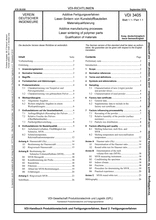Standards Worldwide
Standards Worldwide
Phone +49 30 58885700-07

Technical rule [CURRENT]
VDI 3405 Blatt 1.1:2018-09
Additive manufacturing processes - Laser sintering of polymer parts - Qualification of materials
- German title
- Additive Fertigungsverfahren - Laser-Sintern von Kunststoffbauteilen - Materialqualifizierung
- Publication date
- 2018-09
- Original language
- German, English
- Pages
- 26
- Publication date
- 2018-09
- Original language
- German, English
- Pages
- 26
Product information on this site:
Quick delivery via download or delivery service
Buy securely with a credit card or pay upon receipt of invoice
All transactions are encrypted
Short description
Following VDI 3405 Part 1 which introduced several testing methods for part production using the additive laser sintering manufacturing process, this standard presents specific parameters and best practise recommendations for material qualification. The parameters and recommendations presented in this standard relate mainly to the material polyamide 12 (PA12). Explicit references are also made to polyamide 11 (PA11). The extent to which these parameters and recommendations can be transferred to other materials must be verified on a case-by-case basis. The standard defines which characteristics have to be specified in a factory test certificate of the material to be processed. Further influencing factors onto the processability of the powder material are discussed, too. The specification of the particle size distribution, the measurement of the relative powder humidity, the melting and the flowing behaviour of the powder are discussed. The methods to determine the Hausner ratio and the melt volume flow rate (MVR) are presented. The significance of these measurements is discussed using the results of round robin tests.
Content
ICS
25.030
Also available in
Loading recommended items...
Loading recommended items...
